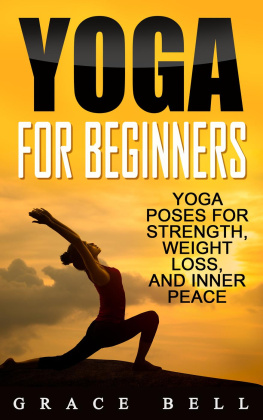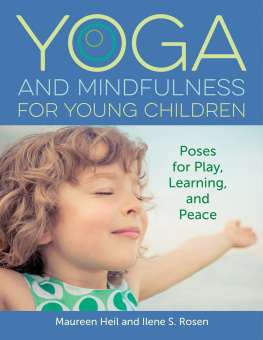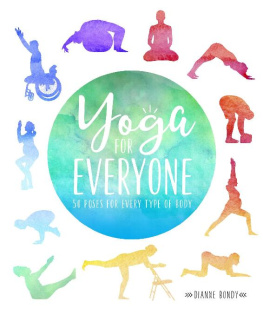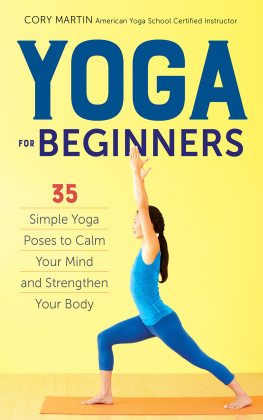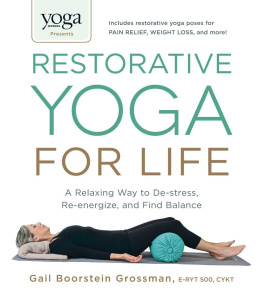Welcome to yin yoga
Please join me on this journey to learn about this slow-paced style of yoga that can provide a gateway to a way of life filled with more relaxation, greater mindfulnessand less stress. While other yoga forms might push you to strengthen and tone your body, yin yoga invites you to be exactly as you are.
Yin yoga has something to offer to everyone regardless of your reason for picking up this book and getting on your yoga mat. If youre interested in the physical practice of yoga, youll enjoy the added flexibility and joint health you feel. But if its the emotional and mental benefits you seek, youll find techniques to increase your mindfulness and to decrease your stress.
For years, I only practiced stronger styles of yoga, such as vinyasa and power yoga. Although I absolutely loved them, I often found myself feeling physically and emotionally drained. I was regularly stressed, had a hard time falling asleep at night, and couldnt meditate for more than 5 minutes at a time. On a hunch, I tried my first yin yoga classand it was exactly what I needed!
Most of us lead lives that are already yang in nature, meaning were active and sometimes even overly active. By only practicing yang styles of yoga and leading a busy life, I was burning myself out and not giving myself the chance to slow down and recharge my batteries.
Yin yoga offered me the opportunity to soothe my nervous system, to let go of the need to always be busy, and to learn to truly relax and be in the present moment.
Today, my life and my yoga practice represent a balance between yin and yang. Because of yin yoga, I know how to properly cope with stress, I fall asleep easily, and I genuinely enjoy sitting in meditation. I feel healthier, calmer, and much more flexiblephysically and mentally.
This books intention is to give you the information you need to begin practicing yin yoga at home on your own. Of course, receiving guidance from a teacher in person is tremendously beneficial, but doing yoga at home is a great way to be consistent in your practice. It also gives you the freedom to create your own sequences and the power to learn what your body needs at any given moment.
I hope this book brings you the gift of physical, mental, and emotional health. Most of all, I hope it inspires you to take the first step toward creating more balance in your life.

Kassandra Reinhardt
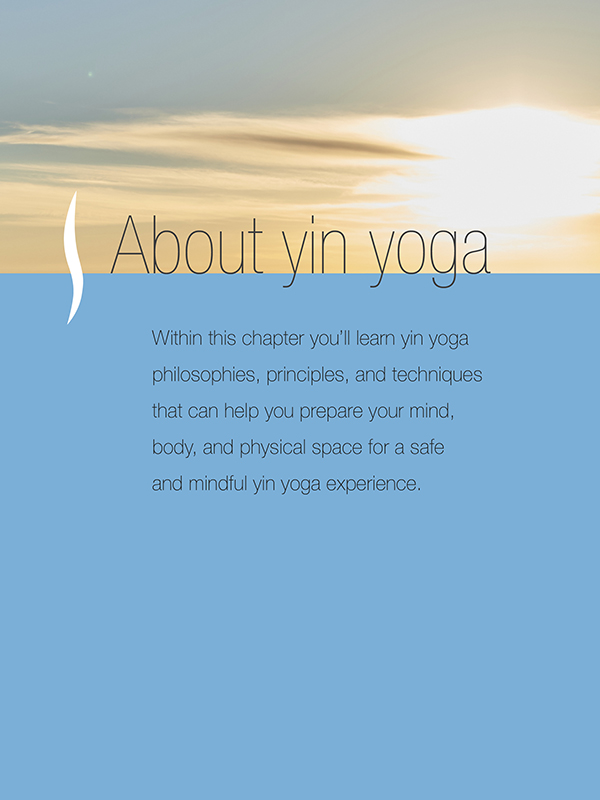
What is yin yoga?
When you hear the word yoga, you might think of such styles as ashtanga, which is physically demanding and requires extreme focus, or bikram (often referred to as hot yoga), which is performed in heated rooms and results in a whole lot of sweat. But yin yoga is different.
The practice
In ancient Chinese philosophy, yin and yang describe how seemingly opposite forces are connected and can help bring balance. This belief also applies to the practice of yoga.
A different style Yin and yang yoga styles move energy throughout the body and help improve physical, mental, and emotional well-being. But yin yoga offers two components that yang yoga lacks: a focus on stillness and an emphasis on longer, deeper stretching of the tissues that surround your bodys moving parts. While most yang styles move quickly and focus on muscle tissues, yin yoga moves slowly and stretches more deeply into the body.
A deeper stretch While most forms of yoga focus on building muscle strength and increasing flexibility, yin yoga centers on stretching deeper connective tissues, such as ligaments, tendons, and deep fasciathe tissue that surrounds muscles. This deeper connection is why yin yoga is often called yoga of the joints.
A passive practice Because you perform yin yoga while sitting or lying down in a passive manner, gravity plays a role in developing a deeper stretch while enabling you to hold poses for longer periods of time. In yin yoga, instead of contracting your muscles to build strength or elevating your heart rate to build stamina, youre encouraged to relax and surrender to gravity.
The principles
Sarah Powers, a pioneer of yin yoga, defined three universally acknowledged principles for every practice that together form the basis for practicing yin yoga safely and effectively.
Find your edge Finding your edgeknowing when to stop during a posehelps create the essential balance between no sensation and too much sensation in the body. You can learn your edge by stopping at a point during a pose where you feel intense sensations. If you go beyond that point, you risk injury.
Be still Once you find your edge, you remain still. Paying attention to your tendency to fidget, move, or mentally distract yourself is the purpose of being still. By achieving a meditative state, youre better able to listen to your body and honor your limits. Being still is critical to your yin yoga practice.
Hold the pose Youll gain the most from your yin yoga practice by holding a pose. While beginning practitioners might start with a 1- to 3-minute hold time, more experienced students might hold asanas anywhere from 5 to 10 minutes.
Ancient originsmodern practice
Yin yoga blends teachings from two different lineages: traditional Indian hatha yoga and the Chinese Taoist yin yang philosophy. Each asanaSanskrit for manner of sittingis derived from hatha yoga, but the process of holding poses for an extended period of time is rooted in Chinese Taoist practices.
Today, yin yoga serves as an antidote to your often stress-filled and busy life, which is typically yang in nature. Too much yang activity can cause an imbalance on physical, emotional, and mental levels. While you never want to be completely yin, true health and well-being come from the practice of balancing the yin and the yang, the passive and the active, and the calming and the stimulating.
Why do yin yoga?
Yin yoga targets your physical, mental, and emotional concerns through deep stretching and breathing. However, unlike most yang styles of yogawhich typically focuses on stretching muscles and emphasize shorter hold timesyin yoga reaches deeper into your body and mind.
Physical benefits
Your physical body will benefit most from practicing yin yoga because it touches every element of your musculoskeletal system. Yin yoga focuses on your fasciatissue around muscles and organsso you should feel improved health on the inside, which should improve how you feel on the outside.
Improved joint health The primary physical benefit of yin yoga is strengthening the connective tissues in your joints. Theyre strengthened through steady, sustained stretching. By applying stress to your joints through stretching, yin yoga helps open and lubricate tight joints.


